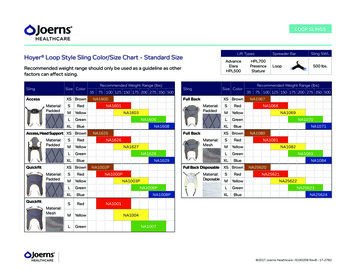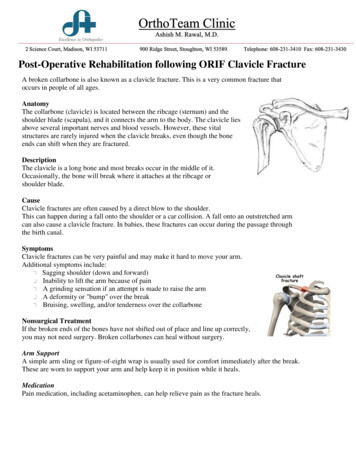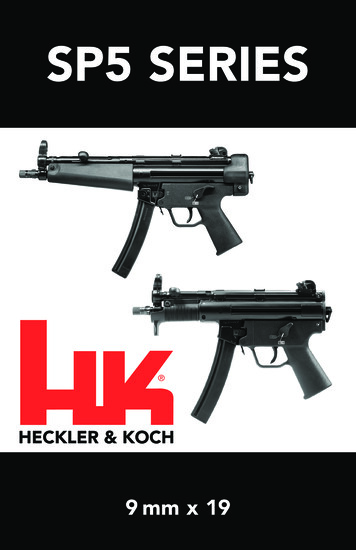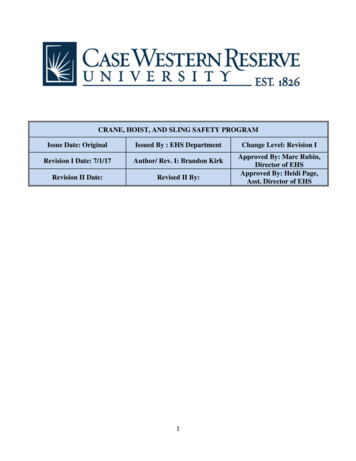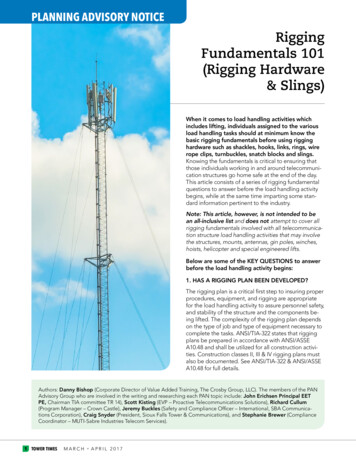
Transcription
Dynamic Sling to Support UpperExtremity Post Brachial Plexus Injury toReturn to Active LifestyleFinal ReportDecember 12th, 2012Team MembersAmy Martin (Team Leader)Lindy Couwenhoven (Communicator)Stephen Monette (BWIG)Clair Kurzynski (BSAC)ClientsKaren Blaschke, OTRMargaret OverstakeAdvisorJohn Puccinelli, Ph.D.1
Table of ContentsAbstract4Problem Motivation5Client Description6Current Devices6Marketed Devices6Past Prototypes8Design Requirements8Design Alternatives9Backpack Design9Ring Design10One Strap Design11Design Matrix12Patient Comfort13Effectiveness13Ease of Use14Adjustability14Safety14Cost14Preliminary Analysis15Final Design16Fabrication182
Testing19Usability19Applied Force20Final Budget22Future Work22Timeline23References25Appendix26Product Design Specifications26Free Body Diagram Analysis29Testing: Raw Data31Usability Testing Evaluation Form33Usability Testing Instructions343
AbstractThe brachial plexus is a network of nerves in the shoulder that can cause varying levels ofsensation and motor loss if damaged [1, 2]. Karen Blaschke is an occupational therapist withUW Hospitals and Clinics, and she works with patients that have experienced brachial plexusinjury including our client, Margaret Overstake. Our design team was asked to create a dynamicsling that would allow someone with a brachial plexus injury to return to an active lifestyle. Thesling should be adaptable for patients at different levels of rehabilitation. The final design wechose to pursue incorporates a chest strap with components that distribute the weight of theinjured arm to the opposite shoulder. Usability and force distribution testing demonstrated thatthe design supports properties specified by the client and design requirements.4
Problem MotivationThe brachial plexus is a network of nerves that provides the arm and shoulder with sensoryperception and motor control [1, 2]. It originates from the cervical region of the spine, thenwraps around the back of the neck and down through the back of the shoulder [3]. Divisions inthe plexus neurons form the ulnar, radial, and median nerves which receive and transmit signalsfrom the arm and hand [3]. This complex anatomical feature is often modeled as a tree becauseof its branching characteristics through the upper back and shoulder, as shown in Figure 1.Figure 1: An anatomical depiction of the brachial plexus. This network of nerves originates atthe spinal cord and branches through the shoulder and upper arm, innervating the entire limb [4].Brachial plexus injury can result from various high-energy trauma accidents such as a long fall,sporting accident, or penetrating injury. The most common causes, however, are road trafficaccidents during which the shoulder is intensely jarred, causing injury due to neural strain [3].The four types of brachial plexus injury are categorized by the type of damage that has occurred[5,6]. Avulsion signifies the detachment of the nerve from the spinal cord and is the most severecase. Similarly, a rupture is a torn nerve, but not at the point where it attaches to the spinal cord.A neuroma refers to a torn nerve that has developed scar tissue, so it no longer functionsnormally. The final and most common type of brachial plexus injury is neuropraxia, which isstretching of the nerve [3, 5, 6]. Although neuropraxia still has a long recovery period, theprobability for regaining function in the limb is greater than for the other three types.Variation exists in the severity level of brachial plexus injuries, making each patient’s recoverytimeline unique [7]. The proximity of the injury to the spinal cord is also a factor that can affectrehabilitation and therapy regimes; if the injury is within the nerve root coming directly from thespinal cord, there is a lesser chance of recovery than if it is in the distal portion of the plexus [3].5
In general, treatments from occupational and physical therapists are prescribed to graduallyregain function in the limb. Initially, muscle movement is incredibly painful, but strength canslowly be regained over the course of two to five years [7, 8]. Some patients do make a fullrecovery, but the outcome is largely based on the individual [3].Client DescriptionKaren Blaschke is a Registered Occupational Therapist in Rehabilitation Medicine withUniversity of Wisconsin Hospitals and Clinics. Our other client, Margaret “Meg” Overstake, is apatient of Karen’s that has suffered a brachial plexus injury. Meg is a working mother seeking toreturn to her normal exercise routine, which includes daily running. Running is a difficult taskfor Meg, as well as others with this injury, because she has not yet gained enough strength in herarm to lift and maintain running form. Both clients would like us to design a dynamic sling thatholds the arm in running position, allowing a patient with a brachial plexus injury to return to anactive lifestyle. The sling will allow for activity at varying levels of rehabilitation while beingable to develop with the patient as they gain strength and function during the recovery process.Karen also envisions using the sling for other rehabilitation applications such as rotator cuffinjuries.Current DevicesMarketed DevicesCurrently, a range of slings exists to support individuals experiencing brachial plexus injury.Again, recovery and rehabilitation regimes vary immensely, so device requirements will differbetween patients. Immediately following the injury, the patient typically wears an immobilizingbrace to prevent large movements of the shoulder and arm that may cause painful burningsensations [7,8]. The slings maintain a 90 degree angle at the elbow, and support the shoulder toprevent subluxation [3]. One example of an immobilizing sling is the Rolyan Universal Sling &Swathe produced by Patterson Medical (Figure 2) [9]. Another example that allows moremovement is the B-Cool Super Sling Plus, also distributed by Patterson Medical (Figure 3) [10].Figure 2: The Rolyan Universal Sling & Swathe immobilizes the arm and shoulder immediatelyfollowing a brachial plexus injury to decrease pain and prevent further injury [9].6
Figure 3: The B-Cool Super Sling Plus maintains a constant elbow angle and allows for slightlymore shoulder motion and use of the hand than the Rolyan model [10].The GivMohr Sling was patented in 2005 and is the closest in function to the current designproject (Figure 4) [11]. The GivMohr Sling is designed for patients reaching the end ofrehabilitation, who wish to enhance their shoulder mobility. Its unique design allows dynamicmotion in the shoulder while maintaining compression throughout the arm, reducing subluxationin the shoulder [11]. By supporting the shoulder, pain and discomfort is reduced and normal armmotion while walking is facilitated. One dissatisfying aspect of the GivMohr Sling is the plasticcomponent that must be held in the user’s hand during wear. The piece is what provides the forceto lift the shoulder, but it hinders the ability to use the hand [7]. Although the sling maintainsnormal arm motion during walking, it lacks the support necessary for running and other highenergy activities.Figure 4: The GivMohr Sling is the standard dynamic sling available on the market. Theplacement of the straps allows for motion in the shoulder. Holding the plastic hand-piece createsa compressive force through the arm that opposes shoulder subluxation, but prevents the wearerfrom using their hand [11].7
Past PrototypesBecause her sling options were few and posed many limitations on her ability to return torunning, Meg initiated the design process on her own during her rehabilitation (Figure 5) [8].Her design used a Thera-band as the main body and strapping material of the sling. She heldboth ends in her hand and the rest wrapped over her shoulder, weaved through the straps of hersports bra, and came back down her arm under her elbow. She incorporated a sleeve made ofsock to keep the Thera-band aligned properly underneath her elbow.Figure 5: Meg created her own sling for running while recovering from her brachial plexusinjury. She wrapped a Thera-band around her hand and wove it through an elbow sleeve madefrom a sock. It then passed up through her sports bra straps and back down to her hand where sheheld it for the duration of her run [8].Design RequirementsThe design requirements within the Product Design Specifications in the Appendix are explainedhere in further detail. Requirements for design fall into one of three major categories: safetyrequirements, client requirements, and patient comfort.Because the device will be used during rehabilitation, safety requirements are critical in ensuringthe sling will cause no harm to an already injured individual. The dynamic sling must fit snuglyto the patient’s arm but not so tight as to hinder blood flow in the arm. Since the wearer mayhave reduced skin surface sensitivity due to neural damage, the device should be designed tominimize the chance of pressure sores or chaffing. Also, the sling must not cause any additionaldamage to the shoulder and arm which may result from lack of proper support or undesiredpressure on the injured shoulder. It should also be noted that if the product were to be marketed,it would require approval from the FDA.8
In addition to safety requirements, the device must also function as required by the client. Theclient has specified that the sling must support the patient’s arm during activities involvingmoderate shoulder motion, so none of its components should restrict movement of the shoulderjoint. The device should also support the elbow at a user-adjustable angle while still permittingsome flexion and extension of the arm. The sling will be an adult size, unisex fit and adjustableto offer support for a wide range of body types. During recovery, the device should allowvarying levels of support for the user to choose from as arm strength increases. The deviceshould maintain functionality throughout the entire course of recovery. Since full recovery is notalways attainable, it would be ideal if the device lasts upwards of 10 years. It is also necessarythat the sling function properly in both indoor and outdoor settings and be constructed fromwashable, water resistant materials.Since the sling may be worn for extended periods of physical activity, care should also be takenin maximizing the comfort of the sling without compromising functionality. It is important thatthe sling can be put on and adjusted using only one arm. The device should be adjustable in sizeand support to fit the needs of the patient. To promote ease of use, the sling must be lightweight(not exceeding 1 kg) so that it can easily be carried with one arm and worn with little to nodetectable weight imbalance. The materials used in the design should be breathable and shouldnot cause any irritation or discomfort to the patient’s skin. Because it will often be worn inpublic, the device should be aesthetically pleasing and simple in appearance.Design AlternativesThe Backpack DesignThis design, as seen in Figure 6, consists of two shoulder straps to be worn similarly to thosefound on a backpack. A short strip of elastic material connects the two straps across the back (a).Arm support is achieved by means of an adjustable and partially elastic band which is connectedto a wrist brace at one end and the back side of the nearest shoulder strap at the other. Theelasticity of the material is attained by layering slack, sturdy strap with a segment of elastic togive stretch with a stopping point (b). Another adjustable band runs from the wrist to an elbowcuff and then up the back of the arm to attach at the same point on the shoulder strap as theprevious band. The elbow cuff is held in place by Velcro fasteners around the arm.The Backpack Design is simple to put on with one hand because it comes as one piece, leavingonly the elbow and wrist components for adjustment once the sling is on the body. The strapconnecting the back of the elbow with the shoulder mimics the behavior of the deltoid muscle tosupport the injured arm. When considering long term comfort, the strapping is low enough on thetorso to prevent chaffing in the underarm region and does not rub on the back of the neck. Thelength and resistance of the elastic piece (b) can be exchanged to accommodate patients atdifferent points in the rehabilitation process.9
(a)(b)Figure 6: Front and back views of the backpack design. The design consists of two straps, anarm support between the injured shoulder and wrist, and a removable elbow component. Letterson the figure correspond to descriptions in the text. (a) Strap connection across the back. (b)Layer of strap over elastic segment to provide flexibility with a stopping point.The Ring DesignThe ring design in Figure 7 consists of two straps that slide onto the shoulders similar to theprevious design, but are connected in an “X” shape across the back with a ring (a). Another strapruns across the upper chest, connecting the right and left shoulder straps. An arm supportcomponent is attached at the back upper shoulder strap, comes down under the elbow, attaches atthe hand near the base of the thumb joint, and returns to anchor at the shoulder. This strapcontains a short elastic segment allowing for a changing elbow angle (b). A wrist brace providesboth a connection for the strap and wrist support. A cup-style support fits under the elbow andhas narrow Velcro or elastic fasteners across the top of the arm to keep the cup in place.The main differences between the Ring Design and the Backpack Design are the back elementand chest strap. The chest strap connects the shoulder straps across the front of the body toprevent undesirable sliding and loosening. The ring differs from the back strap in that itdistributes the tensile forces radially to the mid-back rather than horizontally across the upperback. The resistances and lengths of elastic are exchangeable, and the effort required to put onthe device is comparable to the Backpack Design.10
(a)(b)Figure 7: Front and back views of the ring design. The design consists of two straps connectedby a ring, arm support, and a removable elbow component. Letters on figure correspond todescriptions in the text. (a) Ring connection on the back. (b) Elastic segment in strap that allowsfor movement of the arm.The One-Strap DesignThe one strap design can be seen in Figure 8. The main body of the sling is one continuous “Y”shaped piece (a). One end wraps adjustably around the chest, while the other branches off underthe shoulder blade of the uninjured shoulder, wraps under the armpit and back over that shoulder.From this point it wraps to the back and over the injured shoulder where it attaches to a wristbrace on the injured arm. This attachment point allows adjustment of elbow angle. A slidingfabric strap in the back takes pressure off the back of the neck (b). An elbow strap attachesadjustably to the wrist brace and follows under the elbow, weaving through an elbow sleeve, andup the back of the arm. It weaves through a loop on the closest shoulder strap and clips into thefar shoulder strap. The straps of the sling are made of a sturdy, yet stretchable material forsupport and comfort.The One-Strap Design is a bit more challenging to put on due to the attachment points posteriorto both shoulders. Minimal underarm strapping reduces the potential for chaffing and increasesthe range of motion. The fabric strap on the back symmetrically redistributes the tensile forces atthirty degree angles from the vertical to minimize sling displacement during use. Adjustableconnection points around the chest and at the wrist make the sling usable for a greater range ofbody types than the Backpack and Ring Designs.11
(a)(b)Figure 8: Front and back views of the one strap design. The design consists of one continuousstrap of the same material, with a removable elbow component. Letters on the figure correspondto letters in the text. (a) “Y” shape configuration on the back. (b) Sliding fabric strap takingpressure off the neck.Design MatrixIn order to evaluate each of the three designs, a design matrix was constructed. Each designalternative was evaluated on the criteria of patient comfort, effectiveness, ease of use,adjustability, safety, and cost. The complete scoring breakdown for each design alternative canbe seen below in Table 1. The one strap design scored the highest overall, and was therefore thepursued sling design.12
WeightCriteriaOne StrapBackpackRing25Patient Comfort22182020Effectiveness18121520Ease of 00Total817075Table 1: The design matrix breaks down how well each design alternative follows the criteriaviewed as important based on design and client requirements. The maximum value for eachcriterion are on the left in the column labeled weight and each design was total to be given ascore out of 100 which can be seen in the bottom row of the table. Top scorers in each categoryare highlighted in blue.Patient ComfortPatient comfort was seen as the most important factor in the design and was therefore given thehighest weight of 25 in the design matrix. It is important for the patient to be comfortable whileusing the sling because the design will be used specifically for rehabilitation purposes. The onestrap design will be the most comfortable for the patient due to the location of strapping and wastherefore given 22 points in the matrix. This was followed by the ring design with a value of 20.The ring design allows for a more comfortable strap fit across the back of the patient, yet havingthe ring in the center of the back may be uncomfortable. The backpack design was given thelowest value of 18, with the belief that the horizontal strap across the back may cause discomfort.EffectivenessIt is important that the sling is successful in maintaining support while remaining dynamic duringactivity. The ability of each design to distribute the weight of the injured arm to the oppositeshoulder was also considered. For this reason effectiveness was weighted highly at 20 in thedesign matrix. All three designs would be successful in maintaining support for the patientduring activity. However, the one strap design would allow the weight of the arm to be betterdistributed to both shoulders due to the strap running along the back of the arm and across to theuninjured shoulder. It was therefore assigned 18 points in the matrix. The other two designsscored fairly low in the matrix because the elbow strap is attached to the injured shoulder.13
Ease of UseEase of use was also seen as a significant criterion, so it was given a weight of 20 in the designmatrix. The patient will need to be able to put on and adjust the sling with one arm, and thenumber of components should be minimal so that the sling is easy to use. The backpack and ringdesigns would be the easiest for the patient to put on by themselves and so were assigned 17 and16 points in the design matrix, respectively. The one strap design would be more difficult to puton with the use of one arm due to the intricate strapping, so it was assigned a value of 13 in thematrix.AdjustabilityAdjustability was an important design requirement and was given a weight of 15 in the designmatrix. Adjustability is important so the design can fit varying body types and develop with thepatient as they gain strength and mobility during rehabilitation. The one strap design would beeasily adjustable in fit, but determining resistance adjustability is dependent on the materialsavailable for use. Fit adjustability is demonstrated by the chest strap and lateral movement of theback piece horizontally to accommodate the patient’s body type. The design is also capable ofchanging the arm strap length at the wrist to augment elbow angle. For these reasons the onestrap design was given the highest value of 13 in the matrix. This was followed next by the ringdesign with a value of 11, which allows adjustment of fit in the back but not as significantly asthe one strap design. Finally the backpack design was given the lowest value of nine. Thisdesign would almost require customization to the client’s dimensions because it is nearlyincapable of adjustment.SafetySafety was given a value of 10 in the design matrix because there are few ways that the patientcan be harmed with the use of the sling. However, safety is important because patients may havereduced skin sensitivity, so the sling should not cause pressure sores and should not further injurethe shoulder. The backpack design was seen as the least safe due to the segment of limitedelasticity. This may cause a jerking movement that could be harmful to the patient so the designwas given a value of six. The one strap design was given a value of eight in the design matrixbecause the materials used would be least likely to cause harm to the patient.CostFor the sling to be marketable upon completion, cost must be taken into account. Cost was seenas lower importance due to the simplicity of design materials needed, and was given a weight of10 in the design matrix. However, it should also be affordable for varying incomes and becompetitive with similar slings on the market. Components of the ring design, such as thehardware for the ring itself, were seen as more expensive in comparison to the other two designsand it was therefore given a value of six in the design matrix. Both the backpack and one strapdesigns would cost less to fabricate but the one strap design was given a higher value of eight inthe matrix. The one strap design would be more cost effective because it would use a minimalamount of different materials throughout the device.14
Preliminary AnalysisA free body diagram of the one strap design was used to analyze weight distribution across thedevice (Figure 9). For simplification, analysis was made without the removable elbow support,so the calculations are expected to represent the maximum weight to be carried by the injuredshoulder. Due to this and the symmetric nature of the sling, the force on each shoulder wasfound to be equivalent in this configuration. The weight on each shoulder was calculated to equal0.742 times the weight of the supported arm. For complete analysis and equations, seeAppendix.Figure 9: Free body diagram of the one strap design. FDy represents the force on the shoulderwhile FDG represents the weight of the arm. Full calculations and equations can be found in theAppendix.15
Final DesignThe final design is similar to the One-Strap Design but with several modifications. The sling iscomposed of several separate straps rather than one continuous strap. Encircling the chest is atwo inch wide elastic strap that is fastened to itself in the front using an adjustable Velcrocomponent looped through a ring. The main sling strap is attached to the chest strap under theuninjured arm. It then wraps over the left shoulder to the back where it loops through anotherring. From there, the strap returns to the front over the injured shoulder and ends with a metalring (Figure 10). A Thera-Band of length and resistance to suit the wearer runs from this strap toa dual ring connection on the wrist brace (Figure 11). In the back, a V-shaped segment of fabricstrap paired with a metal ring is used to alleviate pressure on the neck. Fabric loops sewn on topof the primary strap behind each shoulder allow the attachment of a second Thera-Band toprevent the injured shoulder from subluxation (Figure 12). The second Thera-Band is anchoredto an elbow support sleeve with a dual ring attachment (Figure 13). It was determined that a bandconnecting the wrist and elbow components was unnecessary because complete arm support isstill maintained in its absence.Figure 10: Front view of the overall final design showing the Velcro chest strap, the ringconnection at the shoulder, and the elbow and wrist components.16
Figure 11: Wrist component of final design including the dual ring connection for the TheraBand.Figure 12: Back view of the overall final design showing the ring connection at the back as wellas the fabric loops that guide the second Thera-Band from the elbow.17
Figure 13: Elbow sleeve component of final design showing the sewed band for guiding theThera-Band as well as the dual ring connection.FabricationAll fabrication was completed at the UW Orthotics Lab in Middleton, WI where a sewingmachine and materials were readily available. The first step was to cut out and pin together allpieces of the sling. The chest strap was completed first, which required the sewing of a ring andVelcro onto the base material. Spacing for the Velcro was determined based on the waistcircumference of size medium sling models on the market (80-90 cm). Throughout thefabrication process, team members tried on the sling to ensure fit, comfort, and dimensions forall body types and a range of sizes.Next, the back V-strap and ring were sewed to the waist strap. The angle that optimizedplacement in the middle of the back without the straps bunching was approximately 60 degrees.Originally, the V-strap was sewed with folded loops so that it was adjustable horizontally, butthe team decided this extra mobility in the sling shifted too much during use and made the devicemore challenging to put on. In the final design, the V-strap is permanently attached to the cheststrap.18
The elbow and wrist components were the final steps in the fabrication process. Dual metal ringswere attached with strips of fabric on both braces. The location of the rings was optimized toreduce pulling in unintended directions. For example, the thumb hole on the wrist brace isunlined and stretched out very easily when the rings were pinned adjacent to the thumb joint.Moving the rings back towards the wrist joint minimized the deformation in the wrist brace thatwas caused by tension in the Thera-Band.TestingUsability TestingTo collect information about the sling’s comfort and usability, a survey was created anddistributed to thirty test volunteers. The original survey can be found in the Appendix. Datacollected included qualitative questions and timed measurements of how long it took to put onthe sling. About half of the volunteers were engineering students from the Discovery Centeroutside the Student Shop in the Engineering Centers Building. The remaining participants werefriends of design team members.After the test subject agreed to participate in the study, they were given the printed instructions(can also be found in the Appendix) and were allowed about two minutes to read through them.The test administrator repeated the following steps verbally for clarity: no motor control in yourright arm can be used during testing, the table can be used for assistance, instructions can belooked at while putting on the sling, and questions may be asked but their quantity will berecorded. A labeled diagram of the device and several pictures showing the sling being wornwere provided. Since the sling was presented in a disorganized manner as if it had just come outof a box, they were then allowed to arrange the sling to match the diagram. When they wereready, the timer was started and they could put on the sling to the best of their ability. Once thesling was on correctly, the subject was instructed to walk and jog around for at least thirtyseconds to experience the sling’s functionality. Then they took off the sling and completed thesurvey questions. One final, timed attempt of putting on the sling was recorded beforedismissing the participant.Raw data for the usability testing can be found in the Appendix. Tables two and threesummarize the means and standard deviations for each evaluation category and time trials. Toanalyze the data, a Paired Sample T-test was performed to assess whether there was a differencebetween the two timed trials, with the null hypothesis being that there is no difference betweentrials. The test yielded a one-tailed p-value of 1.65x10-5, meaning that there is a significantdifference between the two trials. These results suggest an improvement in the time it takes toput on the sling with repeated trials.19
RatingsMeanStandard 4.070.868Table 2: Mean and standard deviation of the three categories evaluated, on a scale from 1 to 5,by the 30 subjects.Time Trials (sec)Mean (sec)Trial 1112.3Trial 260.63Table 3: Mean time taken to put on the sling by the 30 subjects for two separate trials.Applied Force TestingOne element of the design requirements that was a key feature in determining productfunctionality was the amount of downward force applied on both the injured and uninjuredshoulder during running. The sling was designed to redistribute the weight of the injured armonto the uninjured shoulder to prevent discomfort and further injury.To test this property, a dynamometer was borrowed from Dr. Bryan Heiderscheit that reads amaximum amount of force applied within a duration of time (Figure 14). One of the teammembers put on the sling and another helped hold the dynamometer in place between theshoulder and the sling strap (Figure 15). The wearer was instructed to run in place for five fullarm swing cycles, and the maximum force value was recorded after three trials. The sameprocedure was repeated for both the injured and uninjured shoulders at elbow angles of 30, 45,60, 90, and 120 degrees between the forearm and upper arm.Data points were then analyzed and compared to specifications set forth in the PDS. The forcescollected for each shoulder were divided by the user’s total body mass to calculate a percentage.This calculated value should not exceed ten percent because the force on the shoulder should beless than ten percent of the total body weight, as described in the PDS. These values were thenplotted on a graph comparing the forces to the angle of the elbow (Figure 16). The datademons
4 Abstract The brachial plexus is a network of nerves in the shoulder that can cause varying levels of sensation and motor loss if damaged [1, 2].
